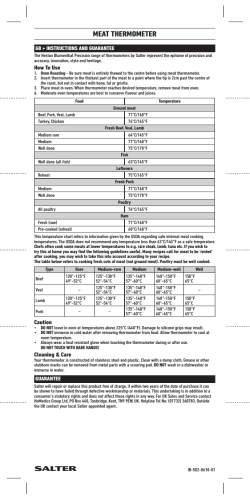
Document 155213
Temperature Notes • Kelvin, Celsius, Fahrenheit • Write notes, put in por7olio. • Everything Underlined – COPY IT! • Study. Read over notes daily. • Enjoy the learning process. • Temperature is how hot or cold something is. Temperature is really a measure of how fast the atoms and molecules that make up a substance are moving (this movement is sub-‐microscopic; you cannot see it). • A thermometer measures the temperature of something, showing how hot or cold it is. • There are many different types of thermometers that measure the temperature of different things. We use thermometers to measure the temperature of the air, our bodies, food, and many other things. There are analog and digital thermometers. An analog thermometer shows the temperature on a scale or dial; a digital thermometer shows the temperature as a number. • The higher the number above zero, the higher the temperature. Copy this table down in your notes. • Temperature is measured in many different scales, including Fahrenheit, Celsius (or CenDgrade), and Kelvin scales. • The units of the Celsius and Fahrenheit scales are called degrees. The symbol for degree is °. • The units of the Kelvin scale are called Kelvins. • A change of one degree of temperature Celsius is the same as a change of one Kelvin. • A change of one degree Fahrenheit is a smaller change in temperature. • Each temperature scale is useful for different things. • Fahrenheit is a measure of temperature that is abbreviated F. • Water freezes at 32°F and boils at 212°F. • This scale was developed by Gabriel Daniel Fahrenheit in 1714. • The Fahrenheit scale is used in the USA but not in many other countries. • The degrees in Fahrenheit are smaller than those in Celsius, making weather-‐related temperatures more easily wriSen (without having to use a decimal point). • Celsius (also called CenTgrade) is a measure of temperature that is abbreviated C. • Water freezes at 0°C and boils at 100°C. • This scale was developed by Anders Celsius in 1742. • Kelvin is a measure of temperature that is abbreviated K. • Kelvin is a temperature scale designed so that 0 (zero) K is defined as absolute zero, and the size of one unit is the same as the size of one degree Celsius. • (Absolute zero is a hypotheTcal temperature at which all molecular movement stops). • All actual temperatures are above absolute zero. • Absolute zero would occur at -‐273.16°C, -‐459.69°F, or 0 (zero) K.] • Water freezes at 273.16K; water boils at 373.16K. • Many scienTsts use this scale (because all the temperatures are posiTve, making calculaTons simpler) or the Celsius scale. • This temperature scale was designed by Lord Kelvin (William Thomson). Conversion Formulas If you know the temperature in one temperature scale you can use a formula to figure out what it is equivalent to in other scales. The conversion formulas are in the table that follows. COPY THIS CONVERSION FORMULA CHART IN YOUR NOTES Temperature Conversion Formulas: COPY THIS CONVERSION FORMULA CHART IN YOUR NOTES Examples: • This example problem illustrates the method to convert temperatures from Celsius to Fahrenheit. • Problem: What is the temperature in Fahrenheit of 20 °C? • SoluTon: • The conversion formula for °C to °F is • TF = 9/5(TC) + 32 • TF = 9/5(20) + 32 • TF = 36 + 32 • TF = 68 °F • Answer: The temperature in Fahrenheit of 20 °C is 68 °F. COPY THIS INFORMATION IN YOUR NOTES Examples: • Here is an example problem that explains how to convert a temperature from degrees on the Celsius scale to Kelvin. • Celsius to Kelvin Problem #1 • Convert 27° C to Kelvin. • Celsius to Kelvin SoluTon #1 • K = °C + 273 • K = 27 + 273 • K = 300 • 300 K • Note that the answer is 300 K. Kelvin is not expressed in degrees. COPY THIS INFORMATION IN YOUR NOTES Examples: • • • • • • • • Celsius to Kelvin Problem #2 Convert 77° C to Kelvin. Celsius to Kelvin SoluTon #2 K = °C + 273 K = 77 + 273 K = 350 350 K COPY THIS INFORMATION IN YOUR NOTES Temperature Unit Conversion Problem Worked Problem ConverTng from Fahrenheit to Celsius and Kelvin • Problem: Express normal body temperature, 98.6°F, in °C and K. • SoluTon: The Fahrenheit to Celsius conversion equaTon may be expressed in this form: • F° = = 1.8(°C) + 32 • Enter 98.6 for the F° • 98.6 = 1.8(°C) + 32 • 1.8(°C) = 98.6 – 32 • 1.8(°C) = 66.6 • °C = 66.6/1.8°C = 37.0 • To solve for Kelvin: • K = °C +273K = 37.0 + 273 • K = 310 • Answer: 98.6 °F is equal to 37.0°C and 310 K COPY THIS INFORMATION IN YOUR NOTES
© Copyright 2025





















